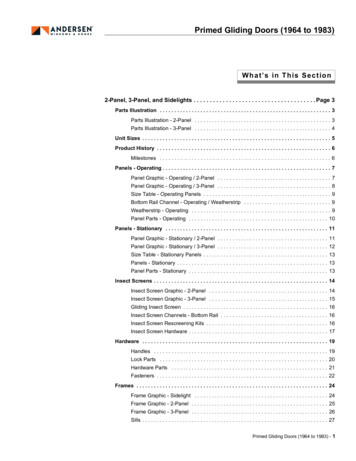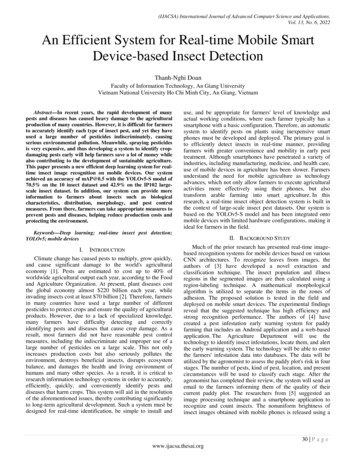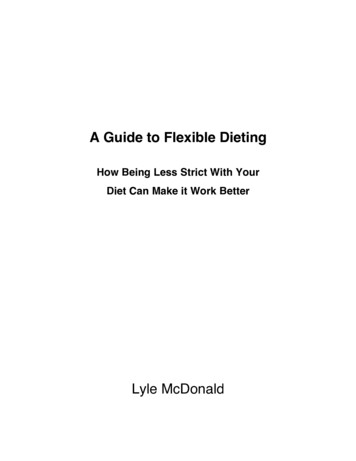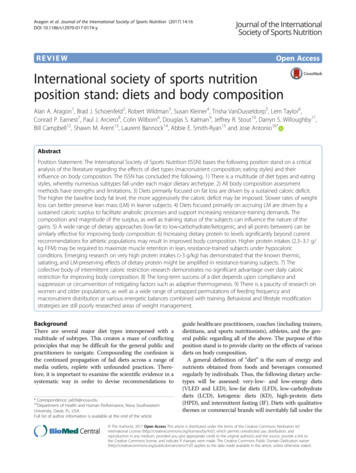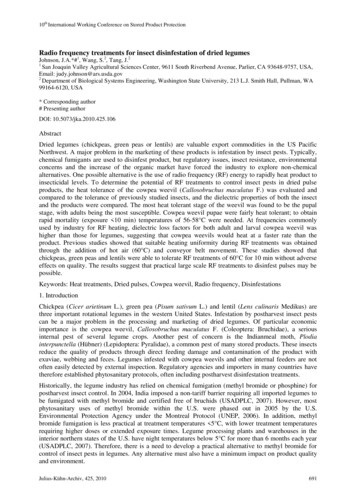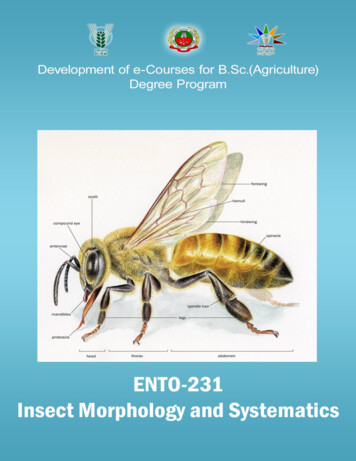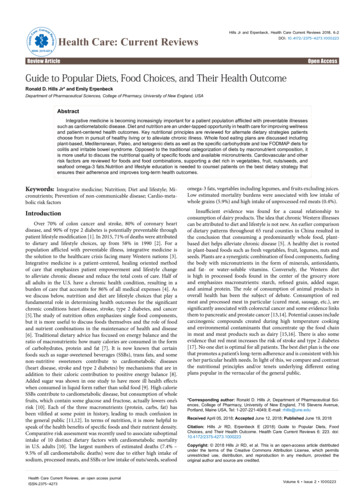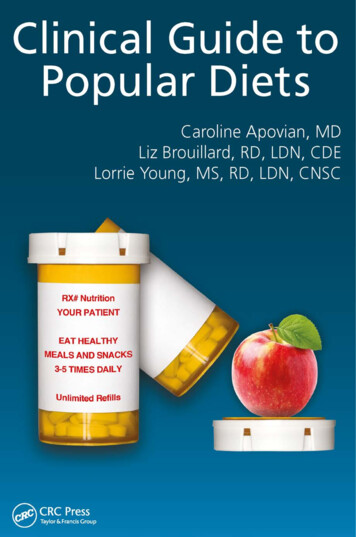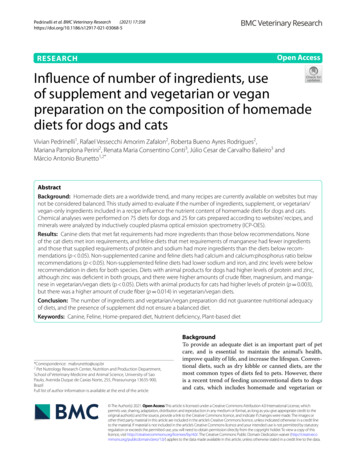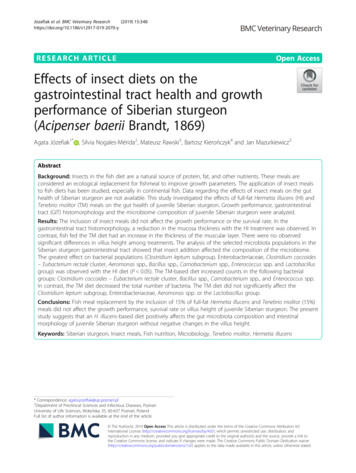
Transcription
Józefiak et al. BMC Veterinary Research(2019) EARCH ARTICLEOpen AccessEffects of insect diets on thegastrointestinal tract health and growthperformance of Siberian sturgeon(Acipenser baerii Brandt, 1869)Agata Józefiak1* , Silvia Nogales-Mérida2, Mateusz Rawski3, Bartosz Kierończyk4 and Jan Mazurkiewicz3AbstractBackground: Insects in the fish diet are a natural source of protein, fat, and other nutrients. These meals areconsidered an ecological replacement for fishmeal to improve growth parameters. The application of insect mealsto fish diets has been studied, especially in continental fish. Data regarding the effects of insect meals on the guthealth of Siberian sturgeon are not available. This study investigated the effects of full-fat Hermetia illucens (HI) andTenebrio molitor (TM) meals on the gut health of juvenile Siberian sturgeon. Growth performance, gastrointestinaltract (GIT) histomorphology and the microbiome composition of juvenile Siberian sturgeon were analyzed.Results: The inclusion of insect meals did not affect the growth performance or the survival rate. In thegastrointestinal tract histomorphology, a reduction in the mucosa thickness with the HI treatment was observed. Incontrast, fish fed the TM diet had an increase in the thickness of the muscular layer. There were no observedsignificant differences in villus height among treatments. The analysis of the selected microbiota populations in theSiberian sturgeon gastrointestinal tract showed that insect addition affected the composition of the microbiome.The greatest effect on bacterial populations (Clostridium leptum subgroup, Enterobacteriaceae, Clostridium coccoides– Eubacterium rectale cluster, Aeromonas spp., Bacillus spp., Carnobacterium spp., Enterococcus spp. and Lactobacillusgroup) was observed with the HI diet (P 0.05). The TM-based diet increased counts in the following bacterialgroups: Clostridium coccoides – Eubacterium rectale cluster, Bacillus spp., Carnobacterium spp., and Enterococcus spp.In contrast, the TM diet decreased the total number of bacteria. The TM diet did not significantly affect theClostridium leptum subgroup, Enterobacteriaceae, Aeromonas spp. or the Lactobacillus group.Conclusions: Fish meal replacement by the inclusion of 15% of full-fat Hermetia illucens and Tenebrio molitor (15%)meals did not affect the growth performance, survival rate or villus height of juvenile Siberian sturgeon. The presentstudy suggests that an H. illucens-based diet positively affects the gut microbiota composition and intestinalmorphology of juvenile Siberian sturgeon without negative changes in the villus height.Keywords: Siberian sturgeon, Insect meals, Fish nutrition, Microbiology, Tenebrio molitor, Hermetia illucens* Correspondence: agata.jozefiak@up.poznan.pl1Department of Preclinical Sciences and Infectious Diseases, PoznanUniversity of Life Sciences, Wołyńska, 35, 60-637 Poznań, PolandFull list of author information is available at the end of the article The Author(s). 2019 Open Access This article is distributed under the terms of the Creative Commons Attribution 4.0International License (http://creativecommons.org/licenses/by/4.0/), which permits unrestricted use, distribution, andreproduction in any medium, provided you give appropriate credit to the original author(s) and the source, provide a link tothe Creative Commons license, and indicate if changes were made. The Creative Commons Public Domain Dedication o/1.0/) applies to the data made available in this article, unless otherwise stated.
Józefiak et al. BMC Veterinary Research(2019) 15:348BackgroundThe Siberian sturgeon (Acipenser baerii, Brandt, 1869) isone of the most valuable fish species in aquaculture. It isfarmed for the production of caviar and high meat qualityfor human consumption [9, 10]. This species, as well asothers in the family Acipenseridae, are known to eat insects, mainly chironomids (Chironomidae) and mayflies(Ephemeroptera) [25, 28, 45], in the wild. The primary preyof shovelnose sturgeon (Scaphirhynchus platorynchus) andpallid sturgeon (S. albus) are the aquatic larvae of Trichoptera, Ephemeroptera, and Diptera [31]. Insects in the fishdiet are a source of protein, lipids, and bioactive compounds, including vitamins, chitin, and antimicrobial peptides (AMPs), which are known to improve the animalimmune system and can modulate the microbiota composition of the gastrointestinal tract [38–41, 61]. In addition,certain insect meals can also provide minerals such as calcium, as with H. illucens, or phosphorus, as with Muscadomestica [51], although the contents of these nutrients depend on the insect diet [30].Although juveniles consume insects in natural conditions, in aquaculture, their diets contain fishmeal (FM)as the main source of protein [15, 56]. However, the useof FM is an environmental concern due to the highamount of wild fish captured for FM production [34].Many alternative protein sources have been studied forgeneral fish nutrition to replace fishmeal. The mostavailable are plant meals. However, some plant meals resulted in growth depression, i.e., soybean meal (SBM)[43], soy protein concentrate, and rapeseed meal [55].Other meals, such as sesame oil cake and corn gluten[37], caused a reduction in growth performance in caseswith inclusion levels higher than 24% and was the samewith wheat gluten [4]. This may be partially explained bythe presence of antinutritional factors such as phyticacid, lectins, saponins, protease inhibitors, glucosinolates, and tannins [18]. Additionally, to achieve optimalgrowth performance using plant meals, it is necessary touse essential amino acid supplementation [86]. Thus, theuse of plant meals is considered a cause of health problems in sturgeon [46, 47].Recently, insect meals have been promoted to replaceFM and/or SBM for fish nutrition, such as the larvae ofgreen bottle fly (Lucilia sericata) used in gilthead seabream (Sparus aurata) meal [11] or superworm (Zophobas morio) for Nile tilapia, Oreochromis niloticus [36].One of the most studied insects as an additive for fishnutrition is the mealworm (Tenebrio molitor), which hasbeen evaluated in rainbow trout (Oncorhynchus mykiss)[5], catfish (Clarias gariepinus) [60], common catfish(Ameiurus melas) [73], guppies (Poecilia reticulata) [2],and European seabass (Dicentrarchus labrax) [21]. Thesecond is the black soldier fly (Hermetia illucens), whichhas also been evaluated in rainbow trout (OncorhynchusPage 2 of 11mykiss) [14, 70, 80], Nile tilapia [58], common carp(Cyprinus carpio) [48] and European seabass [50]. However, in the available literature, there is no informationabout the application of mealworm and/or black soldierfly meals for sturgeon nutrition.Some of the most important factors of animal health include growth performance parameters and gastrointestinaltract (GIT) conditions. There are many data on the impactof nutrition on the gastrointestinal microbiota and guthealth [6–8, 11, 16, 20, 26, 30, 40, 72]. Intestinal diseasescan develop as an effect of unbalanced diets resulting indisturbances in the homeostasis of the GIT microbiome.Therefore, the current study was designed to evaluatethe effects of partial fishmeal replacement with full-fatmealworm and black soldier fly meals for Siberian sturgeon with regard to fish performance parameters, survival rate, GIT microbiota composition and guthistomorphology.ResultsGrowth and feed efficiencyThere were no significant differences among the treatments with regard to BWG, SGR, FCR, and PER at theend of the experimental period (P 0.05). The survivalrate at the end of the trial was 100% for all the treatments (Table 1).HistomorphologyThe mucosa thickness and muscular layer, but not villusheight, (Fig. 2) were affected by dietary treatments (P 0.05). The HI diet caused the highest reduction in mucosalthickness (118 μm) compared to that of the fish fed thecontrol diet (154 μm) and the fish fed the T. molitor(145 μm) diet (P 0.05). In contrast, the T. molitor dietTable 1 Growth and feed utilization parameters of Siberiansturgeon (Acipenser baerii Brandt) fed three experimental diets inwhich fishmeal was partially replaced with full-fat Hermetiaillucens meal (15%) and Tenebrio molitor meal (15%) for 60 days.Data are presented as the mean standard errorDietsSEMpvalueCTTMHIIBW (g)636.67648.33646.676.450.4363FBW (g)1196.811195.041194.8116.440.1178BWG 20.01000.8907All values are means of triplicate cases (n 3). Different alphabetic superscriptsin the same row indicate significant differences at α 0.05IBW initial body weight, FBW final body weight, BWG body weight gainaFeed conversion ratio, FCR feed offered (g)/biomass gain (g)bSpecific growth rate (% day 1), SGR 100 x ln (finalweight/initial weight)/days.cProtein efficiency ratio, PER biomass gain (g)/protein offered (g)
Józefiak et al. BMC Veterinary Research(2019) 15:348Page 3 of 11increased the muscular layer thickness (300 μm) in comparison to that in the fish fed the HI diet (262 μm) and thecontrol diet (243 μm) (P 0.05).Microbiota analysis in the gastrointestinal tract (GIT)The gut microbiota analysis of juvenile Siberian sturgeonfed with HI and TM revealed statistically significant(S 0.05) changes in the following taxonomic groups: theClostridium leptum subgroup, Enterobacteriaceae, Clostridium coccoides – Eubacterium rectale cluster, Aeromonasspp., Bacillus spp., Carnobacterium spp., Enterococcus spp.and the Lactobacillus group (Table 2). The HI-based dietgroup had the highest total number of bacteria in GITdigesta. Compared to that of the CT group, the HI grouphad significantly increased bacterial counts observed for allanalyzed groups of GIT microbiota, including the Clostridium leptum subgroup, Enterobacteriaceae, Clostridium coccoides – Eubacterium rectale cluster, Aeromonas spp.,Bacillus spp., Carnobacterium spp., Enterococcus spp. andthe Lactobacillus group, which changed significantly according to feed type (P 0.05) (Table 2). The TM-baseddiet increased counts in the following groups of bacteria:Clostridium coccoides – Eubacterium rectale cluster, Bacillus spp., Carnobacterium spp., and Enterococcus spp. Incontrast, the TM diet decreased the total number of bacteria. No statistical effect of the TM diet compared to theCT diet was observed in the case of the Clostridium leptumsubgroup, Enterobacteriaceae, Aeromonas spp. and theLactobacillus group.DiscussionTo the authors’ knowledge, the present study is the first attempt to replace fishmeal with full-fat H. illucens and T.molitor meals for Siberian sturgeon nutrition. Currently, themain source of protein for farmed sturgeon is fishmeal withpartial inclusion of plant meals, especially soybean meal [12,35, 74, 83]. However, the present results suggest that insectmeals can also substitute for FM in Siberian sturgeon dietswithout negative effects on growth performance. Moreover,considering the 15% inclusion rate, H. illucens meal represented a 30% replacement of FM protein in the diet, and inthe case of T. molitor, a 40% replacement. Similar valueshave been obtained in experiments conducted with O.mykiss [5], C. gariepinus [60] and C. carpio [48], which alsoconsume insects as part of their natural diet.It is well documented that dietary factors may affect theintestinal morphology, even changing the length of the gutas well as the internal structures, such as the elongation orshortening of the villi, the modification of the goblet cells[76], and the migration of inflammatory cells [83]. Consequently, this affects animal gut health [57]. This could bethe case in the muscularis layer when it thickens, whichhas been associated with the improvement of digestionand absorption [77]. The opposite effect is associated witha decrease in motility in the digestive tract as a degenerative process in aging [78].Therefore, in the current experiment, modification ofthe GIT structures due to the inclusion of full-fat insectmeals in the Siberian sturgeon diet could be beneficial tothe animals by improving the function of the GIT. Interestingly, changes in GIT structures, particularly mucosaland muscular layer thickening, indicate the adaption ofthe GIT to insect-based diets, which are much closer tonatural conditions [28].The structure of the digestive tract differs according to fishspecies. The differences develop in the embryonic stage andare the first factor in gastrointestinal bacterial communityformation. In general, Aeromonas, Pseudomonas, Clostridium and Bacteroides predominate in fish GITs. However,Bacteroides appears late in the gastrointestinal tract of fish,as late as on the 44th day after hatching, but they becomepredominant in the intestines of adult fish.In fish as well as in other vertebrates, gastrointestinalmicrobiota populations strictly correlate with diet andTable 2 Selected intestinal microbiota populations of Siberian sturgeon digesta at the end of the experimental 8.27b8.87abaLOG CFU/g of digestaTotal number of bacteriaClostridium leptum 7.69b7.94a7.73b0.03010.0004baaClostridium coccoides – Eubacterium rectale cluster7.407.667.550.02870.0008Aeromonas spp.8.10b8.45a8.13b0.03 .0001Bacillus spp.8.02c8.42a8.25b0.03 .0001ca8.20b0.03 .0001abCarnobacterium spp.7.97c8.34Enterococcus spp.7.818.218.030.03 .0001Lactobacillus group7.39b8.19a7.96ab0.120.0205All values are means of nine cases (n 9). Different letters indicate significant differences between treatments (P 0.05)
Józefiak et al. BMC Veterinary Research(2019) 15:348GIT functions, as well as the health status and performance of the animals. H. illucens and T. molitor are richsources of small proteins and peptides with balancing effects on GIT microbiota [39]. They are known to act asprebiotics, improving the gut absorptive area [27], selectively stimulating the growth of beneficial bacteria overdetrimental pathogenic bacteria [27], fungi and viruses[85]. They also improve the oxidative status of fish [27],promoting the colonization of beneficial gut microbiota.In addition, chitin in the exoskeleton of insects has antioxidant activity in low amounts as well as antifungal andantiviral properties [3]. Additionally, GIT morphologyand animal growth are dependent on the gut bacterialcommunity [66].All of the analyzed bacterial groups consist of importantbacterial populations of the GIT microbiome. Moreover,Lactobacillus, Enterococcus, Carnobacterium, Bacillus, Aeromonas and Clostridium are some of the most common probiotics used in aquaculture practices, which suggests thatinsect meals with the above bacterial strains may providehealth benefits for Siberian sturgeon breeding [59].Phylogenetic analyses of the 16S rRNA genes from the Siberian sturgeon gut microbial communities showed that themost abundant phyla detected in the fish hindguts wereFusobacteria, Firmicutes and Proteobacteria [22, 23]. Fusobacteria are represented mainly by Fusobacterium [22, 23].The most frequent classes within the Firmicutes phylumwere Clostridia and Bacilli [22, 23]. The most dominantbacterial populations in the Proteobacteria gamma subclasswas the genus Aeromonas and the family Enterobacteriaceae[23, 32]. Aeromonas are frequently identified in carnivores,omnivores and planktivores and make up natural and important parts of the fish gut microbial community [13]. Thegenus Aeromonas cover a diverse group of gram-negativebacteria that are commonly present in aquatic environmentsand soil, as well as in various animals and humans. Aeromonads are ubiquitous bacteria in fresh water and have beenidentified as potential pathogenic bacteria that cause fishskin changes and a variety of human diseases associated withintestinal and extraintestinal infections [65]. Aeromonas isalso a potential foodborne pathogen for humans. However,the epidemiology of human disease is still unclear; therefore,they need to be considered with regard to public health [62].A study performed on Arctic charr, Salvelinus alpinus,showed that a commercial diet changed gut microbial diversity [71, 72]. In the GIT of fish maintained in freshwater andseawater, approximately 55% of the bacterial flora was Enterobacteriaceae. However, when the fish were fed a commercial diet, the dominant microflora in feces wereAeromonas and Pseudomonas [72]. According to the resultsof other studies, Aeromonas and Lactobacillus bacteria predominate in the intestinal microbiome of fish inhabiting natural water bodies, whereas Enterobacteriaceae, whichcomprise up to 50% of all bacteria, are prevalent in thePage 4 of 11microbiota of farmed fish that are fed artificial food [20].However, modification of the bacterial community is an important factor for disease prevention and treatment.In the current study, Aeromonas spp. increased withthe HI treatment, while a TM diet did not statisticallychange the aeromonad population, which may suggestthat HI (15%) may change the GIT microbial diversity ofjuvenile Siberian sturgeon, leading to aeromonad domination in relation to Enterobacteriaceae.High values of the Enterobacteriaceae family were alsoobserved in the digesta of fish fed the HI diet. This couldbe explained according to the findings of Borrelli et al.[8], who noted that H. illucens significantly increased thediversity within the microbial population. In addition,the presence of bacteria that belong to the Enterobacteriaceae family is considered normal in fish farmed nearhuman populations [80–82].Clostridium leptum subgroups are known to producebutyrate products, which contribute to human intestinalhealth [44, 52]. Changes in the Clostridium leptum subgroup is an indicator of the health status of the gut. Species of this genus produce organic acids, includingbutyrate, acetate, lactate, or formate, but not propionicand succinic acids, as primary products of dietary fiberfermentation. Reduction in the number and diversity ofthe Clostridium leptum subgroup is observed in humanCrohn’s disease and ulcerative colitis [44], which couldcontribute to reduced short-chain fatty acids. The abundance of E. rectale and Clostridium leptum indirectly affects epithelial cell structure and function, particularly inthe lower regions of the GIT [52]. In our study, the HIadditive significantly increased the counts of Clostridiumleptum, while no significant differences were observed inthe TM diet group and the control group. IncreasedClostridium counts were also observed in the Clostridium coccoides – Eubacterium rectale cluster in the HIand TM diets.Another potentially positive effect on gut health statusis an increase in the number of Bacillus spp., which oneof the most common probiotics used in aquaculture[23]. A study performed by Ghosh et al. (2002) identifieddifferent members of the Bacillus genus as B. circulans,B. pumilus and B. cereus [24]. The study of bacterial isolates indicated that they could adapt to a wide range oftemperatures and pH. Autochthonous bacteria thatremained present in the GIT possessed enzymatic activitythat might have had beneficial effects on fish health [24].The effect of endogenous Bacillus circulans was also investigated by Geraylou et al. [23] in a study performed on juvenile Siberian sturgeon (Acipenser baerii). The authorsidentified Lactococcus lactis subsp. lactis and Bacillus circulans isolated from the hindgut of juvenile Siberian sturgeonas a new class of candidate prebiotics [23]. Moreover, several studies have demonstrated the immunomodulatory
Józefiak et al. BMC Veterinary Research(2019) 15:348effects of Bacillus spp., including the improvement ofphagocytosis in C. catla and the resistance to salinity,temperature, ammonia and pH changes by the larvae ofAcipenser percicus [17, 23]. In the current study, Bacillusspp. were increased with HI and TM treatments, whichmay suggest improvement of the positive bacterial barrieragainst fish pathogens and may enhance host defense immunomodulatory effects.Another bacterial group isolated from the gastrointestinaltract that produces inhibitory substances against bacterialfish pathogens was Carnobacterium spp. Lactic acid bacteria(LAB) were isolated from fish and screened for bacteriocinproduction and immunomodulatory effects [64]. The studyby Pilet et al. (1995) indicated that Carnobacterium piscicolaand Carnobacterium divergens isolated from fish could produce bacteriocins active against Listeria monocytogenes [64].Bacteriocin-producing bacterial strains belonging to the genera Carnobacterium and Lactococcus and Enterococcus wereisolated from fish intestines, smoked fish and even marinefish. The genus Enterococcus includes more than 30 species.However, the most prevalent species in foods are Enterococcus faecalis and Enterococcus faecium. Some enterococcihave bacteriocinogenic potential and are capable of inhibiting the growth of pathogenic bacteria.In our study, the bacterial counts of Carnobacteriumspp., Enterococcus spp. and the Lactobacillus group weresignificantly different. The results of the TM treatment onLAB bacteria indicated an increase in Carnobacteriumspp. and Enterococcus spp., while no differences were indicated in the Lactobacillus group of bacteria. This may suggest a greater increase in LAB in the HI diet than that inthe TM diet. However, both HI and TM diets caused anincrease in probiotic bacterial populations to have ahealthy effect on juvenile Siberian sturgeon.Another possible cause could be attributed to dietary fatand carbohydrates, which are considered major factors formodification of the gut microbial community profile. Manystudies reported that a high-fat diet increased the population of Enterobacteriaceae and Lactobacillus spp. [29, 49].These results were also confirmed in our studies. The dietwith HI had a higher fat content with greater Enterobacteriaceae and Lactobacillus group populations than did theTM diet, which did not cause changes in the Enterobacteriaceae and Lactobacillus bacterial communities. The effectsof different lipid and carbohydrate contents in the dietswere observed by Ringø and Olsen [71] in Salvelinus alpinus fed with different levels of carbohydrates/lipids. Nevertheless, as Borrelli et al. (2017) noted, the acquiredmicrobial richness may potentially provide further metabolic capabilities to the host, which could be the case forSiberian sturgeon fed a diet with HI [8]. In the case of theTM diet, the effects of this insect meal seemed to be similarto those of the CT diet. However, if we examine growthperformance and microbiota, these values were not enoughPage 5 of 11to cause health problems for Siberian sturgeon or alteredweight gain during the experimental period.In general, the increase of bacterial populations observedin this study should be considered a positive effect that mayimprove fish health. Intestinal microbiota play an indispensable role in the origin of gut health. Host microbiotahomeostasis is an important factor in the first line ofdefense against pathogens. Moreover, diversification of themicrobial population of the fish GIT is very important inestablishing health status, and it can diversify enzymatic potential to interfere with host metabolism [20]. Gastrointestinal bacteria take part in nutrient digestion to provide thehost enzymes, amino acids and vitamins [49]. Furthermore,the diversity of symbiotic gut microflora might also be a potential mechanism for the regulation of bacterial homeostasis by IgA. IgA is the major antigen-specific mechanism bywhich the immune system directly interacts with and influences the luminal microbiota and supports host–microbiota homeostasis [63].Additionally, the insect meals seemed to improve therelationship between GIT morphology and the gutmicrobiome, promoting the health of the fish with survival and growth performance similar to those fed withfishmeal. That was not the case in S. aurata fed with amix of plant meal, which seriously affected the survivalof the animals; Estruch et al. (2015) associated this mortality with certain bacterial consortia within the plantmeal diet [16].ConclusionThe current preliminary study demonstrated that the inclusion of 15% of H. illucens and T. molitor full-fat meals in Siberian sturgeon diets resulted in the same growthperformance and feed efficiency as those obtained with fishmeal. The HI-based diet caused certain modifications ofthe intestinal histomorphology and microbiology, namely, areduced thickness of mucosa, increased muscle layer thickness and an increase in the total number of bacteria in thefollowing groups: the Clostridium leptum subgroup, Enterobacteriaceae, Clostridium coccoides – Eubacterium rectale cluster, Aeromonas spp., Bacillus spp., Carnobacteriumspp., Enterococcus spp. and the Lactobacillus group.In contrast, the TM diet increased the thickness of themuscular layer. Both the HI and TM diets did not elicitsignificant differences in villus height. There was no effect of the TM diet on the intestinal population of theClostridium leptum subgroup, Enterobacteriaceae, Aeromonas spp., the Lactobacillus group, and Enterococcusspp. Changes in microbiota composition and intestinalmorphology contributed to the gut health status of Siberian sturgeon. Moreover, it could be concluded thatthe H. illucens-based diet has a higher potential formodulation of the GIT microecosystem compared to theT. molitor diet. However, these changes could be
Józefiak et al. BMC Veterinary Research(2019) 15:348attributed to other factors that did not affect the performance of the fish during the experiment and needfurther microbiological studies. In addition, other trialsshould be conducted in Siberian sturgeon fed differentlevels of insect meals to find the maximum amount thatthe animal could accept without negatively affecting thefeed efficiency parameters and health. In addition, weshould determine whether the morphological changeswould be harmful to animal health or only an adaptationto the insect meal.The insect diet including Hermetia illucens (15%) andTenebrio molitor (15%) did not affect the growth performance, survival rate or villus height and can be considered as a partial replacement of other protein sourcesin juvenile Siberian sturgeon. The results of the presentstudy indicated that an insect diet including H. illucenscan have a positive effect on the gut microbiome composition and intestinal morphology of juvenile Siberiansturgeon.MethodsExperimental dietsThree extruded isonitrogenous (53.20 0.12% CP) and isoenergetic (17.50 0.07 MJ) diets were prepared by replacingfishmeal (FM) in the control (CT) diet with 15% Hermetiaillucens (HI) larvae meal and 15% Tenebrio molitor (TM)larvae meal (Table 3). These three diets were referred to asthe CT diet, HI diet, and TM diet. The full-fat insect mealswere prepared by HiProMine S.A. (Poland). They were driedat 50 C for 48 h until they reached 95% dry matter.In all diets, blood meal, yeasts, postextraction soybeanmeal, dried whey and wheat gluten were added as protein sources supplements at the same levels. The uses ofthese meals are approved according to EU regulations.The diets were prepared with a cooking extrusion processusing a semi-industrial single-screw extruder (type S-60,METALCHEM Gliwice, Poland). The extrusion conditionswere as follows: 90 C cylinder temperature in the zone ofincreasing pressure, 100 C cylinder temperature in the zoneof high pressure, 110 C head temperature, 52 rpm speedscrew and 6 mm nozzle diameter.Proximate composition and amino acid analysisChemical analyses of the dietary ingredients were performed prior to diet formulation. Diets and their ingredients, as well as the whole fish, were analyzed according toAOAC [1] procedures. Crude protein, (N 6.25) was analyzed by the Kjeldahl method after acid digestion (Kjeltec2300 Auto Analyser, Tecator Hogänas, Sweden). Crudelipid (CL) was extracted with methyl–ether (Soxtec 1043extraction unit, Tecator, Sweden). Dry matter analysis wasperformed using the Polish Standard PN-ISO 6496 andash analysis was performed using the Polish StandardPN–76 R 64795. For crude fiber determination, the PolishPage 6 of 11Table 3 Ingredients and composition (%) of experimental dietsfor Siberian alworm, TM (Tenebrio molitior)b0015Black soldier fly, HI (Hermetia illucens)b0150Red blood cells (dried)c101010Yeastsd888Post-extraction soybean meale101010Dried whey555Wheat gluten777Wheat meal19.115.917.1Fixogran222Rapeseed zol AD3Eg0.10.10.1Choline chloride0.20.20.2Vitamin C0.50.50.5TOTAL %100100100CT – control treatment – 26% of fishmeal, HI – 15% of Hermetia illucens full-fatmeal and 18.4% of fishmeal, TM – 15% of Tenebrio molitor full-fat meal and15.6% of fishmealaDanish fishmeal: DM: 90%; CP: 72%; CF: 12%; Ash: 14%. Skagen, DenmarkbBlack soldier fly meal: DM: 97.5%; CP: 40.4%; CL: 33.5%; Ash: 7.13%.Mealworm meal: DM: 93.9%; CP: 56.3%; CL: 25.3%; Ash: 4.53%. HiProMineS.A. PolandcSpray dried, 900 g kg 1 protein, APC Europe, SpaindYeast, 45% protein, 6% asheSolvent extracted: 45% proteinfPolfamix W, BASF Polska Ltd. Kutno, Poland – containing per 1 kg: vitamin A1000000 IU, vitamin D3 200,000 IU, vitamin E 1.5 g, vitamin K 0.2 g, vitamin B10.05 g, vitamin B2 0.4 g, vitaminB12 0.001 g, nicotinic acid 2.5 g, D-calciumpantothenate 1.0 g, choline chloride 7.5 g, folic acid 0.1 g, methionine 150.0 g,lysine 150.0 g, Fe 2.5 g, Mn 6.5 g, Cu 0.8 g, Co 0.04 g, Zn 4.0 g, J 0.008 g,gVitamin premix AD3EC, BIOWET Drwalew, Poland – contains in 1 kg: vitamin A50000 IU, vitamin D3 5000 IU, vitamin E 30.0 mg, vitamin C 100.0 mgStandard PN-EN ISO 6865 was used (Table 4). All analyses were performed in triplicate.The amino acids of
0.05). The HI diet caused the highest reduction in mucosal thickness (118 μm) compared to that of the fish fed the control diet (154 μm) and the fish fed the T. molitor (145μm) diet (P 0.05). In contrast, the T. molitor diet Table 1 Growth and feed utilization parameters of Siberian sturgeon (Acipenser baerii Brandt) fed three experimental .
